Candle nut, Country walnut
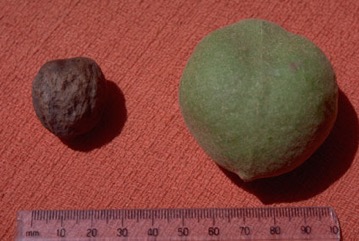
It is a tropical tree. It mostly grows in the lowland rainforest but can be at up to 2000 m altitude. It suits drier climates but can grow in humid conditions. It does well on well drained sandy soil. It must have a temperature above 8°C. In the Pacific it usually grows between 0-700 m altitude in areas with a rainfall of 600-4,300 mm per year. It can grow in arid places. It suits hardiness zones 10-12.
Also known as:
Ai-kami, Akhrot, 'Ama, Bancoulier, Belgaum walnut, Buah kareh, Buah keras, Calunban, Candleberry, Hai, Kabakanjagala, Kanyin-ni, Kekuna, Kemiri, Kuikui, Kukui, Kyainthee, Lama, Lauci, Lumbang bato, Mai-yao-lik, Mak-man-yao, Mat-yao-hkai, Mayow, Miri, Munchang, Nbu, Napa, Nepa, la India, Nues de Pu'a, Qereqere, Rama, Sekeci, Shan-kanyin-ni, Sikeci, Sikethi, Tanyin-si, Taw-thit-kya, Tel kekuna, Tiairi, Toto, Tutui, Tuitui, Waiwai
Synonyms
- Aleurites ambinux Pers.
- Aleurites angustifolia Vieill. ex Guillaumin
- Aleurites commutata Geiseler
- Aleurites cordifolia (Gaertn.) Steud.
- Aleurites cordifolius (Gaertn.) Steud.
- Aleurites integrifolia Vieill.
- Aleurites javanica Gand.
- Aleurites lanceolata Blanco
- Aleurites lobata Blanco
- Aleurites moluccanus var. floccocus Airy Shaw
- Aleurites remyi Sherff
- Aleurites triloba J. R. Forst. & G. Forst.
- Camirium moluccanum (L.) Kuntze
- Camirium cordifolium Gaertn.
- Camirium oleosum Reinw.
- Croton moluccanus L.
- ? Dryandra oleifera Lam.
- Jatropha moluccana L.
- Juglans camirium Lour.
- Mallotus moluccanus (L.) Mull.Arg.
- Manihot moluccana (L.) Crantz
- Ricinus dicoccus Roxb.
- Rottlera moluccana (L.) Scheff.
- Telopea perspicua So. ex Seem.
Edible Portion
- Kernel, Seeds, Nuts, Vegetable
Where does Candle nut grow?
Found in: Africa, American Samoa, Asia, Australia, Bangladesh, Brunei, Cambodia, Central Africa, China, Congo DR, Cook Islands, Cuba, Dominican Republic, East Africa, East Timor, Eswatini, Fiji, French Polynesia, FSM, Grenada, Guam, Haiti, Hawaii, India, Indochina, Indonesia, Kosrae, Laos, Malawi, Malaysia, Marquesas, Mexico, Micronesia, Mozambique, Myanmar, New Caledonia, New Zealand, Pacific, Pakistan, Palau, Papua New Guinea, PNG, Philippines, Pohnpei, Polynesia, Rotuma, Samoa, SE Asia, Slovenia, Solomon Islands, South Africa, Southern Africa, Sri Lanka, Swaziland, Tahiti, Taiwan, Thailand, Timor-Leste, Tonga, Uganda, United States, Vanuatu, Vietnam, Wallis & Futuna, West Africa, West Africa, West Timor, Zambia, Zimbabwe
Notes: The black soot from the burnt seeds is used as a black paint for faces. There are 2-5 Aleurites species.
Status: A reasonably important nut in several areas of Papua New Guinea. It is a cultivated food plant.
Growing Candle nut, Country walnut
Cultivation: The trees grow wild but are transplanted. Often candle nut trees are just self sown, growing in the bush where the seeds fell. These small trees can be transplanted to a more suitable place if needed. Seeds are very hard shelled. To get seeds to start growing more quickly, the seed coat needs to be cracked. To do this a single layer of seeds are put on the ground covered with dry grass then burnt. Immediately after burning while the seeds are still hot they are thrown into cold water, and then planted. This cracks the shells allowing more rapid germination. Without this it may take many months for this hard shell to break down and germination to commence. Trees can also be grown from cuttings.
Edible Uses: The nuts are normally roasted. The hard, oily nut is used for thickening in Asian dishes. They are used in a sauce for the greens eaten with rice. CAUTION The nuts contain a moderately poisonous substance so should be cooked before eating. The raw kernels of candle nut are poisonous. They are a strong purgative. Before eating they must be well cooked. Mostly the nuts are roasted in the fire until the shell is blackened and half burnt, then the kernels are taken out by cracking the shells. The nuts should probably only be eaten in moderate amounts. Because the kernels are high in oil, they can be burnt as candles. An edible oil can be extracted from the nuts.
Production: The tree grows quickly. They can grow 0.5-1.5 m in a year. Yields of 30-45 kg of nuts can be produced on a tree in one year. Yields of 80 kg per tree are possible under good cultivation. Trees can start producing after one year.
Nutrition Info
per 100g edible portion| Edible Part | Energy (kcal) | Protein (g) | Iron (mg) | Vitamin A (ug) | Vitamin c (mg) | Zinc (mg) | % Water |
|---|---|---|---|---|---|---|---|
| Kernel | 580 | 7.8 | 2.7 | - | - | 2.7 | 24.4 |
| Kernel cooked | 678 | 20.6 | 22.6 | - | - | 3.2 | 1.4 |
| Kernel treated | 335 | 0.5 | - | - | - | - | 12.8 |
Candle nut, Country walnut Photos

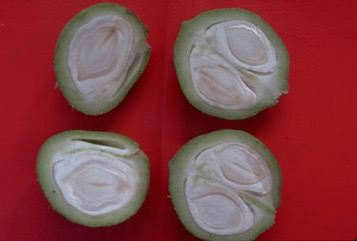
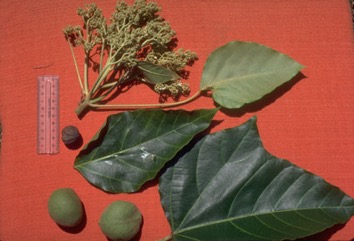
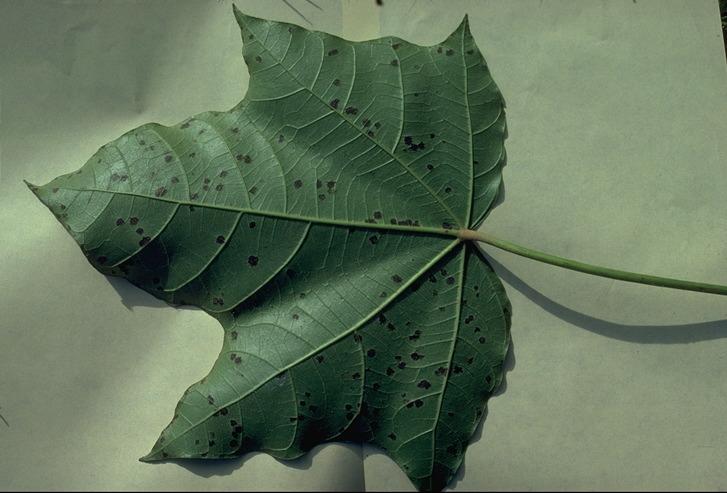
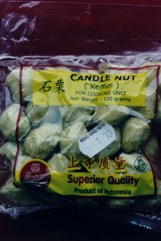
References
Candle nut references
Altschul, S.V.R., 1973, Drugs and Foods from Little-known Plants. Notes in Harvard University Herbaria. Harvard Univ. Press. Massachusetts. no. 2351
Ambasta S.P. (Ed.), 2000, The Useful Plants of India. CSIR India. p 26
Barrau, J., 1976, Subsistence Agriculture in Polynesia and Micronesia. Bernice P. Bishop Museu, Bulletin 223 Honolulu Hawaii. Kraus reprint. p 56
Barwick, M., 2004, Tropical and Subtropical Trees. A Worldwide Encyclopedic Guide. Thames and Hudson p 19
Bircher, A. G. & Bircher, W. H., 2000, Encyclopedia of Fruit Trees and Edible Flowering Plants in Egypt and the Subtropics. AUC Press. p 17
Bodkin, F., 1991, Encyclopedia Botanica. Cornstalk publishing, p 64
Bourret, D., 1981, Bonnes-Plantes de Nouvelle-Caledonie et des Loyaute. ORSTOM. p 21
Bremness, L., 1994, Herbs. Collins Eyewitness Handbooks. Harper Collins. p 35
Brown, F.B.H., 1933, Flora of South Eastern Polynesia 3, Dicots. Bishop Museum Bulletin 130 p151
Brown, 1951, Useful Plants of the Philippines 3 vols. p 281
Burkill, H. M., 1985, The useful plants of west tropical Africa, Vol. 2. Kew.
Burkill, I. H., 1935, A Dictionary of the Economic Products of the Malay Peninsula 2 vols. p 92.
Chandrashekara, U. M., 2009, Tree species yielding edible fruit in the coffee-based homegardens of Kerala, India: their diversity, uses and management. Food Sec. 1:361-370
Cherikoff V. & Isaacs, J., The Bush Food Handbook. How to gather, grow, process and cook Australian Wild Foods. Ti Tree Press, Australia p 144, 198
Clarke, W.C. & Thaman, R.R., 1993, Agroforestry in the Pacific Islands: Systems for sustainability. United Nations University Press. New York. p 222
Cooper, W., & Cooper, W.T., 1994, Fruits of the Rainforest. RD Press. p 26, 27
Cooper, W. and Cooper, W., 2004, Fruits of the Australian Tropical Rainforest. Nokomis Editions, Victoria, Australia. p 171
Corner, Wayside Trees of Malaya.
Cribb, A.B.& J.W., 1976, Wild Food in Australia. Fontana, p 78, plate 3
Cronin, L., 1989, The Concise Australian Flora. Reed. p 169
Cundall, P., (ed.), 2004, Gardening Australia: flora: the gardener's bible. ABC Books. p 124
Darley, J.J., 1993, Know and Enjoy Tropical Fruit. P & S Publishers. p 75
Dastur, J.F., 1951, Useful Plants of India and Pakistan. p 24
Dharani, N., 2002, Field Guide to common Trees & Shrubs of East Africa. Struik. p 47
Duke, J.A., 1989, CRC Handbook of Nuts CRC Press p 12,13
Elevitch, C.R.(ed.), 2006, Traditional Trees of the Pacific Islands: Their Culture, Environment and Use. Permanent Agriculture Resources, Holualoa, Hawaii. p 41
Elliot, W.R., & Jones, D.L., 1982, Encyclopedia of Australian Plants suitable for cultivation. Vol 2. Lothian. p 173
Etherington, K., & Imwold, D., (Eds), 2001, Botanica's Trees & Shrubs. The illustrated A-Z of over 8500 trees and shrubs. Random House, Australia. p 85
Facciola, S., 1998, Cornucopia 2: a Source Book of Edible Plants. Kampong Publications, p 100
Flora of Pakistan. www.eFloras.org
Franklin, J., Keppel, G., & Whistler, W., 2008, The vegetation and flora of Lakeba, Nayau and Aiwa Islands, Central Lau Group, Fiji. Micronesica 40(1/2): 169–225, 2008
French, B., 1986, Food Plants of Papua New Guinea, Asia Pacific Science Foundation p 181
French, B.R., 2010, Food Plants of Solomon Islands. A Compendium. Food Plants International Inc. p 198
Friday, J. B., 2005, Forestry and Agroforestry Trees of East Timor. http://www.ctahr.hawaii.edu/forestry/data/Timor/Timor trees.html
Gillaumin, R., 1954, Les Plantes utiles des Nouvelles-Hebrides (fin et complement) In: Journal d'agriculture tropicale et de botanique appliquee Vol. 1, No. 10-12 pp 453-460
Gilliland, H.B., 1962, Common Malayan Plants Univ of Malaya.
GTZ 1996, A Guide to some Indigenous Fijian Trees. GTZ Suva. p 115
Hariyadi, B., 2008, The Entwined Tree: Traditional Natural Resource Management of Serampas, Jambi, Indonesia. Ph. D thesis. Univ. or Hawaii. p 427
Havel, J.J., 1975, Forest Botany, Volume 3 Part 2 Botanical taxonomy. Papua New Guinea Department of Forests, p 143
Hedrick, U.P. (ed). 1919, Sturtevant's Edible Plants of the World. Dover p 32
Hemphill, I, 2002, Spice Notes. Macmillan. p 94
Hiddins, L., 1999, Explore Wild Australia with the Bush Tucker Man. Penguin Books/ABC Books. p 133
Henty, E.E., 1980, Nuts. Proc. 2nd PNG Food Crops Conference.
Henty, E.E., 1980, Harmful Plants in Papua New Guinea. Botany Bulletin No 12. Division Botany, Lae, Papua New Guinea. p 49, 48
Hill, M. & Hallam, D., (eds), 1997, Na Hang Nature Reserve, Tat Ke Sector. Site description and conservation evaluation. Hanoi. p 77
Hutton, W., 1997, Tropical Herbs and Spices of Indonesia. Periplus. p 16
Hu, Shiu-ying, 2005, Food Plants of China. The Chinese University Press. p 509
Jones D, L, 1986, Ornamental Rainforest Plants in Australia, Reed Books, p 180
Johns, R.J., 1976, Common Forest Trees of Papua New Guinea. Part 5 Angiospermae, Forestry College Bulolo, PNG p 224
Katende, A.B., Birnie, A & Tengnas B., 1995, Useful Trees and Shrubs for Uganda. Identification, Propagation and Management for Agricultural and Pastoral Communities. Technical handbook No 10. Regional Soil Conservation Unit, Nairobi, Kenya. p 90
Kiple, K.F. & Ornelas, K.C., (eds), 2000, The Cambridge World History of Food. CUP p 1743
Krishen P., 2006, Trees of Delhi, A Field Guide. DK Books. p 155
Kunkel, G., 1978, Flowering Trees in Subtropical gardens. p147
Lamberton, K (Ed.), 2004, The Australian gardening encyclodepia. Murdoch Books, NSW Australia. p 156
Lamoureux, C.H., 1976, Trailside Plants of Hawaii's National Parks. Hawaii Natural History Association. p 43
Latham, P. & Mbuta, A. K., 2014, Useful Plants of Bas-Congo Province, Democratic Republic of Congo. Volume 1. p 34
Latham, P. & Mbuta, A. K., 2017, Plants of Kongo Central Province, Democratic Republic of Congo. Volume 1. 3rd ed p 35
Lazarides, M. & Hince, B., 1993, Handbook of Economic Plants of Australia, CSIRO. p 13
Lebot, V. & Sam, C., Green desert or ‘all you can eat’? How diverse and edible was the flora of Vanuatu before human introductions?. Terra australis 52 p 410
Leon, J., 1968, Fundamentos Botanicos de Los Cultivos Tropicales. p 348
Liefting, A., et al, Samoan plant names. http://en.wikipedia.org
Llamas, K.A., 2003, Tropical Flowering Plants. Timber Press. p 187
Lord, E.E., & Willis, J.H., 1999, Shrubs and Trees for Australian gardens. Lothian. p 12
Low, T., 1991, Wild Food Plants of Australia. Australian Nature FieldGuide, Angus & Robertson. p 93
Low, T., 1992, Bush Tucker. Australia’s Wild Food Harvest. Angus & Robertson. p 90, 91
Massal, E. and Barrau, J., 1973, Food Plants of the South Sea Islands. SPC Technical Paper No 94. Nounea, New Caledonia. p 32
Menninger, E. A., 1977, Edible Nuts of the World. p 49 Horticultural Books.
Miguel, E., et al, 1989, A checklist of the cultivated plants of Cuba. Kulturpflanze 37. 1989, 211-357
Neal, C.M., 1965, In Gardens of Hawaii. Bishop Museum Press p 504.
Nicholson, N & H., 1996, Australian Rainforest Plants 2, Terania Rainforest Publishing. NSW. p 6
Ochse J.J., 1931, Vegetables of the Dutch East Indies. p 262
Owen, S., 1993, Indonesian Food and Cookery, INDIRA reprints. p 68
Oyen, L.P.A., 2007. Aleurites moluccana (L.) Willd. [Internet] Record from Protabase. van der Vossen, H.A.M. & Mkamilo, G.S. (Editors). PROTA (Plant Resources of Tropical Africa / Ressources végétales de l’Afrique tropicale), Wageningen, Netherlands. < http://database.prota.org/search.htm>. Accessed 13 October 2009.
Peekel, P.G., 1984, (Translation E.E.Henty), Flora of the Bismarck Archipelago for Naturalists, Division of Botany, Lae, PNG. p 312, 311 Perry, F., and Hay, R., 1982, Guide to Tropical and Subtropical Plants. Sun Books p 10
Plants of Haiti Smithsonian Institute http://botany.si.edu/antilles/West Indies
Plants of Papua New Guinea LAE herbarium record (As var. floccosa)
Powell, J.M., Ethnobotany. In Paijmans, K., 1976, New Guinea Vegetation. Australian National University Press. p 108
Price, S.H. & J.L., Wild Food, Medicine and useful plants of the Wet tropics. Kwik Kopy, Cairns. p 4
Radke, P & A, Sankowsky, G & N., 1993, Growing Australian Tropical Plants. Frith & Frith, Australia. p 16
Recher, P, 2001, Fruit Spirit Botanical Gardens Plant Index p 1
Royal Botanic Gardens, Kew (1999). Survey of Economic Plants for Arid and Semi-Arid Lands (SEPASAL) database. Published on the Internet; http://www.rbgkew.org.uk/ceb/sepasal/internet [Accessed 16th April 2011]
Safford, W.E., 1905, Useful Plants of Guam.
Sam, H. V. et al, 2004, Trees of Laos and Vietnam: A Field Guide to 100 Economically or Ecologically Important Species. BLUMEA 49: 201-349
Seidemann J., 2005, World Spice Plants. Economic Usage, Botany, Taxonomy. Springer. p 14
Segura, S., et al, 2018, The edible fruit species in Mexico. Genet Resour Crop Evol (2018) 65:1767–1793
Slik, F., www.asianplant.net
Smith, A.C., 1981, Flora Vitiensis Nova, Lawaii, Kuai, Hawaii, Volume 2 p 548
Solomon, C., 2001, Encyclopedia of Asian Food. New Holland. p 63
Sotheeswaran, S., and Sharif, M. R. et al, 1994, Lipids from the seeds of seven Fijian plant species. Food Chemistry. 49:11-13
Sp. pl. 4(1):590. 1805 "moluccana"
Staples, G.W. and Herbst, D.R., 2005, A tropical Garden Flora. Bishop Museum Press, Honolulu, Hawaii. p 281
Sunanto, H., 1997, Kemiri Komoditas Ekspor, Penerbit Kanisius, Jogyakarta
Sukarya, D. G., (Ed.) 2013, 3,500 Plant Species of the Botanic Gardens of Indonesia. LIPI p 119
Sukenti, K., et al, 2016, Ethnobotanical study on local cuisine of the Sasak tribe in Lombok Island, Indonesia. Journal of Ethnic Foods. 3 (2016) 189-200 p 198
Suwardi, A. B., et al, 2020, Ethnobotany and conservation of indigenous edible fruit plants in South Aceh, Indonesia. Biodiversitas Vol. 21, No. 5, pp 1850-1860
Swaziland's Flora Database http://www.sntc.org.sz/flora
Tanaka,T., 1976, Tanaka's Cyclopedia of Edible Plants of the World. Keigaku Pub. Co., Tokyo.
Thaman, R.R., 1976, The Tongan Agricultural System, University of the South Pacific, Suva, Fiji. p 378
Thaman, R. and W. Clarke, Paper on Agroforestry on Aneityum and Tanna, Vanuatu from Internet
Townsend, K., 1994, Across the Top. Gardening with Australian Plants in the tropics. Society for Growing Australian Plants, Townsville Branch Inc. p 75
United Nations University. Appendix One hundred Pacific Island agroforestry trees (2)
van Wyk, B., 2005, Food Plants of the World. An illustrated guide. Timber press. p 46
Walter, A & Sam, C., 1995, Indigenous Nut Trees in Vanuatu: Ethnobotany and Variability. In South Pacific Indigenous Nuts. ACIAR Proceedings No 69. Canberra. p 57
Walter, A. & Sam C., 2002, Fruits of Oceania. ACIAR Monograph No. 85. Canberra. p 87
Wealth of India. 1948, p48
Whistler, W.A., 2004, Rainforest Trees of Samoa. Isle Botanica Honolulu, Hawaii. p 55
Wickens, G.E., 1995, Edible Nuts. FAO Non-wood forest products. FAO, Rome. p 121
Williamson, J., 2005, Useful Plants of Malawi. 3rd. Edition. Mdadzi Book Trust. p 18
Wit, F., 1979, Tung, in Simmonds N.W.,(ed), Crop Plant Evolution. Longmans. London. p 74
http://www.worldagroforestrycentre.org/sea/products/afdbases/af/asp
Flora of Thailand. www.nationalherbarium.nl/thaueuph/
Van Sam, H. et al, 2004, Trees of Laos and Vietnam: A Field Guide to 100 Economically or Ecologically Important Species. Blumea 29 (2004) 201-349
Wong, M., 2006, Edible Plants for Hawai'i Landscapes. College of Tropical Agriculture and Human Resources. Univ. of Hawai'i
World Checklist of Useful Plant Species 2020. Royal Botanic Gardens, Kew
Yuncker, T.G., 1959, Plants of Tonga, Bernice P. Bishop Museum, Hawaii, Bulletin 220. p 164
Zawiah, N. & Othaman, H., 2012, 99 Spesies Buah di FRIM. Institut Penyelidikan Perhutanan Malaysia. p 20